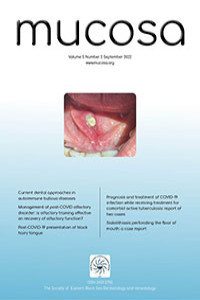Müköz membran pemfigoidi
Müköz membran pemfigoidi (MMP), pemfigoidlerin müköz membranları etkileyen alt tipidir. Klinik semptomlar ve hedef antijenlere göre, oküler müköz membran pemfigoidi (OMMP) ve anti-laminin332 MMP(anti-LN-332 MMP) gibi çeşitli alt tiplere ayrılmıştır. Başlıca hedef antijen 180 kDa (BP180) olmakla birlikte, epidermal bazal membran bölgesindeki (EBMZ) çeşitli yapısal proteinlere karşı otoantikorlar mevcuttur. BP230, α6β4 integrin ve laminin 332 gibi diğer antijenler de, bu otoantikorlar tarafından hedef alınabilmektedir. MMP klinik olarak, oral mukozada (%85), konjuktivada (%65), daha az sıklıkta ise, burunda (%20-40), özefagusta (%5-15), farinkste (%20), larinkste (%5-10) ve genitallerde (%20) erozyon ve büllerle karakterizedir. MMP'nin klinik şiddeti, farklı klinik tiplerinde önemli farklılıklar gösterir.OMMP ve anti-LN-332 MMP klinik tiplerinde aktif hastalık uygun bir biçimde tedavi edilmediğinde körlük veya üst havayolu obstrüksiyonu ile sonuçlanan ilerleyici skar gelişimi hastalığın ciddi bir komplikasyonudur. Önceleri, MMP ile eş anlamlı olarak kullanılan skatrisyel pemfigoid, şimdi skarla seyreden deri lezyonlarına sahip nadir klinik fenotipi isimlendirmektedir. Klinik özelliklerdeki değişkenlikler ve klinisyenler arasında aşinalığın azlığı, MMP tanısında, hasta ve doktor kaynaklı gecikmelere yol açmaktadır. Doğru tanı için, direkt immünofloresan mikroskopik inceleme ve serumda otoantikorların gösterilmesi zorunludur. MMP'nin yönetimi ve prognozu hastalığın yaygınlığı ve şiddeti ile ilişkili olup basamaklı bir yaklaşım ile, ilk seçenek olarak oral kortikosteroidleri (KS) ve sıklıkla uzun dönem KS kullanımının yol açabileceği yan etkileri azaltmak için adjuvanlarla kombinasyonu içerir.
Mucous membrane pemphigoid
Mucous membrane pemphigoid (MMP) is the subgroup of pemphigoid which affects mucous membranes. Several sub-types are classified based on clinical symptoms and target antigens, such as ocular mucous membrane pemphigoid (OMMP), localized vulvar pemphigoid (LVP) and an-ti-laminin 332 MMP (anti-LN-332 MMP). Autoantibodies are directed against various structural proteins in the epidermal basement membrane zone (EBMZ), with the 180-kD antigen (BP180) as the main target antigen. Other antigens, such as BP230, α6β4 integrin and laminin 332 can also be targeted by autoantibodies. Clinically MMP is characterized by erosions and blistering of the oral mucosa (85%), conjunctiva (65%), and less frequently, the nose (20-40%), esophagus (5-15%), pharynx (20%), larynx (5-10%) and genitals (20%). Clinical severity is highly variable in the different subtypes of MMP. Progressive scar formation is a severe complication in active disease in OMMP and anti-LN-332 MMP, resulting in blindness or upper airway obstruction when not treated accurately. Previously, the term cicatricial pemphigoid was used synonymously for MMP, however, at present the term refers to the rare clinical phe-notype with scarring skin lesions. Patient and doctors delay is frequently seen in MMP because of its variation in clinical presentation and unfamiliarity among clinicians. For an accurate diagnosis, direct immunofluorescence microscopy (DIF) and detection of circulating autoantibodies in serum is mandatory. Management and prognosis of MMP depends on the severity and extent of the disease and involves a stepwise approach with first choice treatment with oral corticosteroids (CS), often used in combination with adjuvant reduce the adverse effects caused by long-term CS use.
___
- 1. Chan LS, Ahmed AR, Anhalt GJ, et al. The first international consensus on mucous membrane pemphigoid: definition, diagnostic criteria, pathogenic factors, medical treatment, and prognostic indicators. Arch Dermatol 2002;138:370-9.
- 2. Schmidt E, Zillikens D. Pemphigoid diseases. Lancet 2013;381:320-32.
- 3. Egan CA, Lazarova Z, Darling TN, Yee C, Yancey KB. Anti-epiligrin cicatricial pemphigoid: clinical findings, immunopathogenesis, and significant associations. Medicine (Baltimore) 2003;82:177-86.
- 4. Domloge-Hultsch N, Gammon WR, Briggaman RA, Gil SG, Carter WG, Yancey KB. Epiligrin, the major human keratinocyte integrin ligand, is a target in both an acquired autoimmune and an inherited subepidermal blistering skin disease. J Clin Invest 1992;90:1628-33.
- 5. Terra JB, Pas HH, Hertl M, Dikkers FG, Kamminga N, Jonkman MF. Immunofluorescence serration pattern analysis as a diagnostic criterion in antilaminin-332 mucous membrane pemphigoid: immunopathological findings and clinical experience in 10 Dutch patients. Br J Dermatol 2011;165:815-22.
